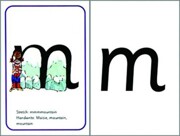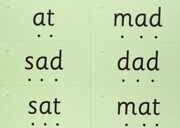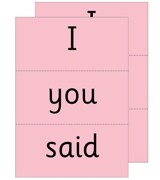- Home
- Parents
- Read Write Inc. Phonics
Read Write Inc. Phonics
Read Write Inc. is a popular phonics scheme. Like all phonics schemes, it teaches children the sounds in English, the letters that represent them, and how to form the letters when writing. Read Write Inc. Phonics includes reading books written using only the letters they have learnt at each level (and a small number of separately taught tricky words). The children will quickly feel confident and successful.
Here you can find lots of free resources to support your child’s learning.
Free eBooks | Videos | Set 1 resources | Set 2 resources | Set 3 resources | Kits and flashcards to use at home
More information about the Read Write Inc. Phonics Scheme that is used at St. Edward's CofE Primary School and Nursery can be found by following the link below.
A Guide to Read Write Inc. for families
Your child will begin the Read Write Inc Phonics programme when they start at St Edward’s in FS1 and FS2.
What is Read Write Inc?
When teaching your child to read, we never use letter names at this early stage. Many schools use different phonics schemes to teach children to read, at St Edward’s, we believe Read Write Inc Phonics is the best scheme to support your child in learning to read. Your child will be assessed and grouped according to their phonics ability. Children will then receive their phonics teaching as part of a whole class and read books matched to their phonological knowledge. Read Write Inc. uses pure sounds, it removes the 'uh' sounds from words.
Speed Sounds
When teaching your child phonics, we will use the term 'speed sounds’, these are individual sounds which your child will learn how to read quickly and effortlessly as they progress through Reception, Year 1 and Year 2. Your child will be regularly assessed to ensure they are reaching their full potential and will receive additional booster sessions if appropriate.

Phoneme
Your child will learn a new sound every day accompanied by a handwriting rhyme which helps them to remember how to form the letter shape when writing it. If your child is in FS1, they may learn a sound a week or over several days as it is important that your child learns how to distinguish sounds. A phoneme is the smallest unit of sound in speech, this may be one letter, or a group of two or three letters which make one sound. For example, if your child was learning the phoneme (sound) ‘a’, they would also learn the rhyme ’round the apple and down the leaf’ when they start to write their letter. In set 1, your child will learn 44 phonemes.
Blending
As your child learns each sound (phoneme), they are taught how to blend the sounds together to make two and three letters words (CVC words, consonant, vowel, consonant such as the word dog). Your child will learn how to read real and nonsense words.
Green Words
Alongside this, your child will start to read 'green' words. 'Green' words are words which can be sounded out and blended like ‘dog’, ‘cat’.

Red Words
Having gained confidence sounding out green words, your child will be taught about ‘red' words. These words are tricky words, words which can’t be sounded out phonetically like ‘to’ and ‘go’. Your child will start to learn the 'red' words I, the and my. They will also learn why these words are tricky and cannot be sounded out. I says it's name as in the alphabet song whilst with the word 'the', we don't say the 'e' and with 'my', the 'y' is pretending to be an I. As your child progresses through FS2 and KS1 (Year 1 and Year 2), they will learn these 'red' words by sight.

Fred Talk
At school we use a puppet called Fred who can only speak in sounds, not whole words. We call this Fred Talk. For example, Fred would say d-o-g, we would say dog. Your child is taught to hear sounds and blend them together in sequence to make a word.
Fred Fingers
Fred Fingers are used for spelling. Your child is taught to sound out the word they are spelling and put up the correct number of fingers for the sounds they can hear in that word. For example: m-ee-t = 3 sounds = 3 fingers. When your child starts to write words, they will be taught to use their 'Fred Fingers':
Say the word.
Hold up correct number of Fred Fingers.
Palm facing you.
Say the word again.
Pinch the sounds. (Gently pinch each finger as you say the sound)
Write the sounds.
Add sound buttons/dashes.
Phonics Screening Check
In Year one, your child will have a Government Led, phonics screening check, this is normally held around June. The purpose of the check is to confirm whether individual children have learnt decoding and blending skills to meet an age-appropriate standard. The phonics screening contains 40 words and your child will work one-to-one with the teacher, reading words out aloud. There will be a combination of real words and nonsense words.
There is not a set time limit to complete the screening in but it usually takes between 4-9 minutes. If your child's teacher thinks it would be appropriate, your child can have a break or stop if they are struggling. If your child does not meet the pass mark they will have to retake the screening test in Year 2. (You will be informed on their end of year school report on this).
By the end of year 1 it is expected that children are able to recognise the grapheme-phoneme correspondences, segment and blend them confidently in words. For the past few years the expected pass mark has been 32 out of 40. However, the Department for Education does not release the pass mark until a few weeks after the children have completed the check.
Here are some tips to help children of all ages to enjoy reading and to get reading more often.
- Take breaks while reading.
- Build reading into your child's daily routine.
- Encourage your child to follow their interests.
- Use technology together.
- Encourage your child to be the author, retell or make up stories.
- Have a chat.
Listening to your child reading is important. However, your child hearing your read or tell a story is just as important. This will support them to develop new vocabulary, learn how to use expression in their voice. Encourage your child to decode the sounds e.g. segmenting or drawing on sound buttons. When you are out and about read signs around you. Practise speed reading the sounds your child has been learning in school.
My child won’t read, no matter what I do. How can I help?
Read to your child as much as possible
Don’t make an issue out of it
Talk to your child’s class teacher - working together will help
Useful Terminology
blend – to draw individual sounds together to pronounce a word, e.g. s-n-a-p, blended together, reads snap.
digraph – A digraph is a single sound, or phoneme, which is represented by two letters like ‘ow’ as in ‘s-n-ow’ reading ‘snow’.
grapheme – A grapheme is a letter or a number of letters which represent a sound (phoneme) in a word.
grapheme-phoneme correspondence (GPC) – the relationship between sounds and the letters which represent those sounds; also known as ‘letter-sound correspondences’. This means that your child will be able to recognise and/or identify the written form of a letter when listening to the sound.
phoneme – A phoneme is the smallest unit of sound in speech, this may be one letter, or a group of two or three letters which make one sound.
segment – to split up a word into its individual phonemes (sounds) in order to spell it, e.g. the word ‘cat’ has three phonemes: c – a – t,
sound buttons – the number of phonemes (sounds) in a word, your child will be encouraged to draw a dot under a single letter to denote the number of sounds, if it is a digraph they will underline both sounds instead of drawing a dot. For example ai in snail.
split digraph – two letters (consonants), split by another letter (vowel), but which make one sound, e.g. a-e as in make or i-e in site.
trigraph – A trigraph is a phoneme which consists of three letters like ‘air’ as in ‘hair‘. 3 letters making 1 sound.
| Document Title |
|---|
| Read Write Inc Parent Reading Booklet 1 1 |
| Document Title |
|---|
| Read Write Inc Parent Reading Booklet 2 |